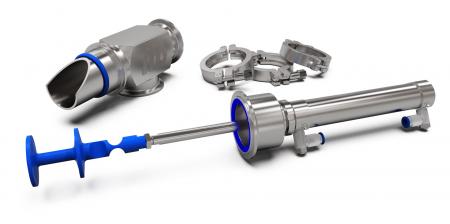This article discusses:
- Different purposes of pipe couplings
- Sealing joints
- The developments regarding the standardization of new pipe couplings
The experts at Dinnissen Process Technology are available to answer all your questions:
Get in touch with Juul Jenneskens 077 467 3555
Purposes of pipe couplings
Pipe couplings are used to make connections between different elements of the equipment. Pipe couplings also offer options for maintenance and replacement. In addition, the equipment can be used for multiple purposes thanks to the connections. With pipe couplings the order or route of the product flow can be adjusted.
Sealing joints
When making a connection, with or without a coupling, it must always be prevented that micro-organisms penetrate. For this reason, the joints should not have passageways caused by porosity or damage. The surface condition of the sealing surfaces of coupling parts plays an important role in this. The surface roughness of the sealing surfaces may therefore be a maximum of 0.8 μm Ra (4 μm Rz).
In figure 1 a clear valley is visible. This is a place where bacteria can hold on to, despite an average surface texture. This valley must therefore be filled as well as possible with a seal that prevents microorganisms from entering. For such a seal often a gasket of rubber is used with a minimum contact pressure of 1.5 N / mm2. The rubber must then have a hardness of 70 ° Shore A, as shown in figure 2. If the rubber is compressed enough and the gasket has lost 15% of its thickness, the contact pressure is 1.5 N / mm2.

Interchangeable pipe couplings
A rubber gasket with a minimum contact pressure of 1.5 N / mm2 is often used for sealing
Developments regarding new pipe couplings
Pipe couplings that are widely used today are under great pressure. The current process conditions are making increasingly higher demands, partly thanks to product innovations and new process methods. The fact that the couplings almost exceed their limits creates an increasingly high risk of hygienic and mechanical problems. Therefore, improved versions of pipe couplings are now being designed. This has resulted in many different types of connections. Almost every major equipment manufacturer has developed its own link. As a result, the links can no longer be used everywhere. In addition, the costs of the links have increased. The European Hygienic Engineering and Design Group (EHEDG), the working group "Pipe Couplings" has been established. This working group will focus on these problems and draw up new guidelines. The working group works together with D.I.N. Normenausschuss Armaturen, because the German industry also has a coupling requirement that must meet very high standards. Together they started the procedure for a Standard Proposal for two types of gasket: a profile gasket designed by APV and an O-ring gasket designed by Tuchenhagen. Both versions are designed for screw couplings and for flange couplings. The hope is that this standard will serve as a basis for a new European Standard. This should ensure, firstly, fewer different couplings on the market and secondly, a safe coupling from a mechanical and hygienic point of view.

Name: Juul Jenneskens
Advisor
Please feel free to contact me if you have any questions about this subject. My team of colleagues and I are ready to answer!
Get in touch with Juul Jenneskens 077 467 3555 [email protected]
Do you prefer to request a consultation directly?
